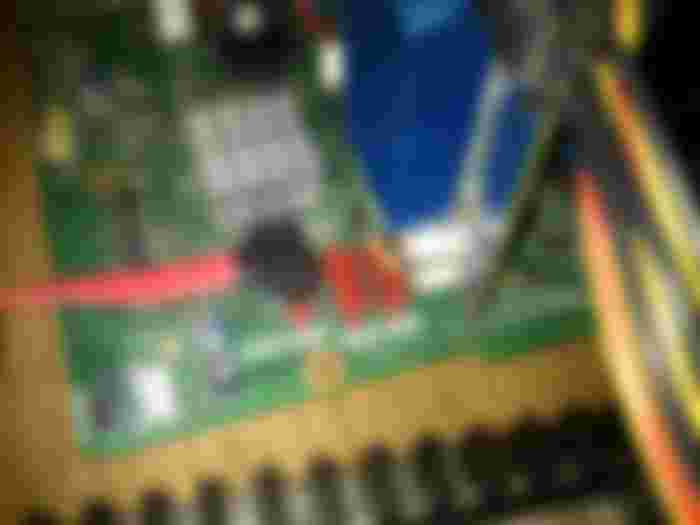Zhaoxin KX-5000 test: the Chinese x86 CPU
This article will introduce the Zhaoxin KX-5000 chip family to the readers. Specifications, and speed tests will be featured here, and background informations will be shared about the Zhaoxin CPU line. The Zhaoxin CPU will be tasked to run frequently used office, productive applications, and video games as well. But first lets see, what is this all about, and why Zhaoxin company has been created in the first place.
Chip independence
As the chip war started to unfold in the last decade, China preemtpively searched for solutions to be able to create its own chips. Various attempts were unsuccesfull, but they managed to acquire the chip technology of VIA.

The new company was tasked to create x86-64 processors. It was called Zhaoxin. Zhaoxin initially used the existing VIA (Centaur) Quacdore cores, which were designed for HTPC and mini-pc environments. Zhaoxin eventually managed to re-design these cores for the PC market. The first CPU designed by Zhaoxin itself is the KX-5000 core.
The KX-5000 uses the "Wudaokou" architecture, and its the first native x86-64 chip implementation from China. Its still heavily based on the original design they got from VIA, as the vendor string is CentaurHauls, which refers to the former CPU design team of IDT. These chips are manufactured either in the Chinese chip-fab HLMC or in the Taiwanese TSMC on a 28nm manufacturing node.
I managed to get hold one of these systems.
The Zhaoxin KX-5000 is not exported outside of China and was mainly used in PCs for the Chinese government.
The KX-6000 series - which was released a year ago - are mainly used in mini PCs and HTPC computers. This is available on the international market, and
will be replaced by the KX-7000 line, which was finally introduced a few weeks ago, after multiple years of delays, promising a giant uplift in IPC.
Despite the KX-5000 chips are available since 2017, no trader seem to have them, and its very hard to order them. The KX-6000 in HTPC form factor are somewhat easyer to be found.
Existing reviews
In the last few years, i haven't seen any interesting tests about these systems. I found no tests beyond running syntethic benchmarks, and executing maybe some random AAA game, which i having no interest in.
I would like not to name any of the reviewers who have dealt with benchmarking this processor. But it seems our world is really heading into the society featured in the movie Idiocracy. One of the most influental reviewers have showcased a Zhaoxin CPU by running CS:GO and Cinebench on it, and for some reason, called it a test. Congratulations for being able to power it on, but i would have expected you guys to deliver an actual test.
Some portals who wrote a review about it, were being fixated on a mystical x86 license which Zhaoxin supposedly has. No such thing as an x86 license exists any more: we are not in 1997. The so called x86 license which they refer to, was Intel's cross patenting agreement with other chip manufacturers of the late 90s to allow using each others patents when designing and selling CPUs in the USA. Patents expire after 20 years in USA, which means even the patents related to the x86-64 has been expired by now (as the first 64 bit x86 CPU was released in 2023). To be more precise, x86 is not a license, its an instruction set.
Some portals say its an Intel Atom level chip without even testing it, probably intentionally defaming the performance of these processors or they are incompetent.
So i decided to take the things into my hands, i will do real life tests both in Linux and Windows, measuring the performance of multimedia, internet browsing, games, and office-type usage. The integrated graphics chip will be also tested.
Meet the Lenovo ZZX200ML1
The star of the test is this motherboard, which has the Zhaoxin CPU integrated on it. According to the previous owner of this motherboard, it was meant as a replacement board for the Lenovo Kaitan. This is a system supposed to be used in computers of the Chinese government. The motherboard was not produced in large numbers, and they were not exported from China. The production date of my board is 2017. The motherboard looks like any cheap OEM board. It has two DDR4 RAM slots, but according to the previous owner, he was not able to operate memory sticks in dual channel in it. So he put one 8 GB ECC (non registered) stick to the board, which was one of the few modules he succesfully got working in it. The internet doesn't knows too much about this motherboard either: a chinese forum however, mentions a design flaw about a heating pad frequently damaging a capacitor underneath it, which later causes a short circuit. As i don't speak Chinese, i can't verify which capacitor they are talking about.

I don't have any USB keyboard right now, the motherboard luckily has a standard PS/2 connector for keyboard and mouse as well. It also has a parallel (LPT) port, which is usually left out from the modern motherboards. There is a slot for an SSD, and three standard SATA port (the fourth is not soldered up). It has VGA and HDMI outputs as well. The motherboard has front USB headers, which are going to be covered if someone uses them in a normal ATX case.
The motherboard is not a real ATX design. The previous owner had to order a converter to it to be able to use it with a standard ATX power supply. The motherboard needs 12v stand-by voltage, so the ATX adapter was made in way that makes the power supply always to be powered on, even if the system is shut down. This is because the stand-by voltage on standard PSU-s are 5v, so it can not be used on this design directly.
The friend of the previous owner found out he can mount a standard AM2 cooler solution on the board, by screwing them from underneath. Very clever design, i left it like that, and this must be enough for the system, as the CPU consumer about 30w power at most.
The motherboard also has a standard PCI port, which is very good for those who still use PCI cards for various purposes (for example SCSI controllers, ancient graphics accelerators, TV cards, multimedia controllers). I have not tested the compatibility of this PCI port yet.
Zhaoxin KX-5640 CPU
The brain of this system is the KX-5640 which is an engineering sample unit. The CPU has 4 cores, and 4 MByte L2 cache. The chip runs at 2 GHz, doesn't supports turbo. The chip runs very cool, with the cooler attached on it, no heat output can be felt when touching the working CPU. The chip is a fully featured SOC, and it has an IGP as well. The south bridge is not a good design. That runs too hot, and it requires an extra fan. If the extra fan thats supposed to cool the chipset is not connected, the bios displays a warning message, and asking you to connect it. The PCI-e slots connecting to the CPU at PCI-E 2.0, but there are not much room to put in very strong graphics cards, if you want to use more than one SATA device: the SATA connector is in the way, and blocks the graphics card from full insertion.
Zhaoxin KX-5640 IGP: the Zhaoxin c860
There are conflicting informations about this chip, if it has the c860 or c960 IGP in it, but i was able to verify its the c860 unit which this has. Its the integrated version of a VIA/S3 x11 design, and supports DirectX 11 and OpenGL 3.2. Zhaoxin replaced this chip with its DX12 graphics solution later on - unlucky for me, i ended up with the earlyer design. This IGP can only support up to 1920x1080 (full HD) resolution, which should be enough for everyone, but as my monitor is 1920x1200 i am not able to use the full resolution of my monitor.

The graphics drivers are very flaky, i tried dozens of Zhaoxin graphics drivers from the website of the manufacturer, and from the Microsoft update catalog, and none of them worked. At the end, i ended up downloading the latest Zhaoxin KX-5000 driver, and modded the inf file by putting the proper device SUB ID strings in place. This allowed me to run the Setup file, which installed the driver without further problems.


Let's power it on!
The entireity of the ZZX200ML1 seems like an engineering sample, however, the BIOS supports everything i need. It has CSM/Mixed mode to use pre-UEFI hardware (which i usually chose to do so), it can set IDE or AHCI modes, and it can even set the memory size of the IGP. It can do quick diagnostics, such as memory test as well. The board has a lot of pins for diagnostic cards to be inserted. First, i was barely able to find, how to power it on, as the front panel header is next to the south bridge, which i haven't noticed first.

The comparison
When using the Zhaoxin KX-5000 series chip for the first time, it doesn't felt too different than my first gen intel i3-550 system. The Intel i3-550 is more than a decade old. It would been better to compare something newer against the Zhaoxin, but the i3-550 is the strongest CPU i have. Greetings from East Europe! The i3-550 will be equipped with 8 GB DDR3 memory. It runs at 3.2 GHz, and has two cores/four logical cores due to hyperthreading. The system has PCI-E 2.0 compatibility as well.
The second test system will be an Athlon2 x4 635, which is a four core CPU at 2.9 GHz. AMD meant the Athlon2 x4 to be the rival of the Intel i5, but in reality it is slower than the first gen i3 in most cases on the same clock speeds. I have only 4 GB DDR3 of memory for this system, but at least it will run in dual channel mode. Otherwise, it feels approximately identical to the i3 and Zhaoxin systems.

The third system, is the embended/laptop processor line of Intel: the Pentium N3710, which is related to the Celeron J and Celeron N series as well. This CPU line got approximately released at the time of the arrival of the Zhaoxin, but it uses the 14nm manufacturing node (unlike the 28nm of Zhaoxin). The N3710 is a passive CPU, and allows laptops to be built with very simple batteries and motherboards yet last half a day when working on it. It will also be equipped with 8 GB of memory.

Linux tests
To carry out the office-type tests, Debian Linux will be used (Debian release 11 with the newest packages available). The 64 bit Debian Linux will be equipped with LXDE to avoid desktop bloat, but its far from being a fresh install: it has various software and packages installed, which i use sometimes, including tools for programming, video editing, even webserver related services are installed and running on the system.
Video conversion
To test the performance of video conversion, the well known ffmpeg will be used. The file i will convert to a h264 mp4 file, is the Combining_2_Videvo_UHD.mov, and its going to be executed in the following way: ffmpeg -i "Combining_2_Videvo_UHD.mov" -s 1280x720 -c:v libx264 -crf 25 -c:a copy -preset veryslow -tune animation kimenet.mp4

The time for the completion will be measured oacross all the chips.
The Zhaoxin was the slowest, and the PentiumN 3710 was only better with a few seconds. The i3 and Athlon2 chips were almost twice as fast, the Athlon2 manages to be faster than the i3 due to its higher core count. This is not a good start for the Zhaoxin, but do not forget the i3 and Athlon2 is running at much higher clock speeds.
Office productivity
In this test, i have measured opening a PDF file in text mode in Libreoffice Write. The time required to open and process this PDF file (which is a motherboard manual) will be measured across all the test systems, to approximate the performance of office-type usage between these systems. This test ran on single thread.

The Pentium N 3710 was the slowest in the test, the Zhaoxin managed to be faster a few seconds. The i3 and Athlon2 chips are almost twice as fast in this test (despite their clock speed is only about 50% higher).
7zip
In this test, i have compressed the Linux kernel to a 7z file. The files were still in cache when i started the compression, to avoid HDD trashing. The Linux kernel is a few 100 MByte package, which got uncompressed, then re-compressed with 7z. Only the compression was measured in this test. 7zip can use multiple threads, but it can't really use more than 2-3 threadseffectively. I was not able to precisely measure this test, so i rounded the results up to minutes.

The Pentium N 3710 was the slowest, then the Zhaoxin follows. The i3 and Athlon2 chips are barely better in this test, not being able to profit too much from their larger clock speeds.
Compiling the Linux kernel
In this test, i have executed a compilation process of Linux kernel with the make -j 4 command, to ensure it uses all the cores (execution threads) of the processors. Compiling the Linux kernel takes a couple of minutes on modern systems, and reflects the speed of C source code compilation very well, when compiling extremely large source code packages.

The Pentium N 3710 was the slowest, the Zhaoxin was faster a few seconds again. The i3 and Athlon2 processors are almost twice as fast again. The i3 is the absolute winner of the test, and even if it only has two cores, it beats the Athlon2 by a few seconds.
Booting the Linux operating system
I have measured the boot time on all systems, except the Pentium N, which ran from an SSD, and it has different services installed, therefore, it wouldn't been comparable with the rest of the systems, so it was not included in this test. The measure begins when grub executes, and ends when the login prompt appears on the screen.

Every system required 50 seconds to boot the system from the hard drive i have used. This is a 7200 RPM hard drive, however, as i have mentioned it previously, this Linux install is full of services, which increase the boot time significantly.
Loading a website
To measure the speed of web browsing, i have opened a private window of chromium, and entered a chat server with rooms and avatars. I started the clock when pressing the enter button, and stopped the measure when the chat scripts, and all the content on the front room got properly loaded and displayed.

This is the first test the Zhaoxin wins, its in pair with the i3 550 chip, being the fastest of the pack. The Athlon2 is quite slow, despite its clock speeds. The Pentium N 3710 finishes last in this test.
The IGP with Opensource games
The Zhaoxin has an IGP as well - the Zhaoxin C-860 is a derivate of a DX11-complaint VIA graphics chip (VX11). The IGP has Windows XP, Windows 7 and Windows 10 drivers, however, it was not a simple task to install it. I have tried various drivers from Zhaoxin and Microsoft as well. None of them seem to be working. The driver was missing the device ID of the KX-5640 chip. When i tried to force the inf files to install from device manager, the system threw them back with an error code. Sometimes, the driver installed, but the system got no 3D acceleration. Eventually, i found out the solution: i had to put the device and sub device ID manually into the inf file, and then starting the setup procedure by executing the setup.exe file solved the problem, and the driver installed without an issue. This is probably due to the fact that my chip is an engineering sample, and it has a different device ID compared to the actual release chips.
Zhaoxin also has drivers for Linux, however, these are for specific systems and specific kernel releases, which are not really useful for this test.
The Athlon2 635 has no IGP, but the motherboard i used with it, has a DX9 class nVidia chip integrated on the motherboard (GeForce 7050) so that will be used in this test.
Supertuxkart
This is a nice opensource game for Linux, it also got ported to Windows, it uses OpenGL 1.3 but the recent versions can also utilize the new modern OpenGL 3 and pixel shaders to produce a good graphics. To have an uniformic result in this test, i have disabled most of the eye candy, and put the graphics settings to medium, which allowed the game to look similarly on every chips despite their pixel shader capabilities.

The game simply crashed on Zhaoxin's IGP, so newest 64 bit version of TitaniumGL had to be used to start the game, which hogged the performance quite a bit. The game was also unplayable on the Athlon2 system with the nVidia chip. The Pentium N produced playable frame rates around 24 fps, and the i3 was a very fluid experience. This is not a good start for the Zhaoxin's IGP.
Torcs
Another opensource game for Linux - which also got ported for Windows. This uses the good old OpenGL 1.1 API to render its geometry, newest versions can benefit from newer extensions as well.

This game was started on every system, but all of the chips ards produced slideshow, except the i5, which was delivering playable frame rates. The Zhaoxin's IGP was the slowest to run this game again (5 fps).
Unigine benchmark
The Unigine is a crossplatform benchmark, and the OpenGL API was used to do the tests. The IGP of the i3 and the Athlon2 was crashed when attempting to run this test (despite the hardware should had the required features to run it).

The Zhaoxin managed to run it at 2 fps, and the Pentium N scored 13 fps. Normally i don't do syntethic benchmarks, but i found this quite interesting to try anyway.
Linux gaming with Radeon 4850
To check the gaming on Linux with a discrete graphics card, i gidded out my good old Radeon 4850 from its grave. The Radeon 4850 was a gamer card from 2008, so its not the newest technology. However, it supports the OpenGL 3.3 API under Linux, allowing basically every Linux game to run perfectly, and its Linux drivers are good and efficient. The card is equipped with 512 MByte video memory (Linux only detects 256 MByte from it for some reason) connected through a 256 bit memory interface. Its a standard PCI-E 2.0 card, and it booted without problems in any of the systems. Even in Zhaoxin. Previously, people mentioned, the Zhaoxin might suffers from booting up PCI-E graphics cards in it - this turned out to be false (of course CSM was enabled in the BIOS).

Supertuxkart
The Zhaoxin and the Athlon2 managed to hit 60 fps and at first i thought this is due to VSYNC. But then the i3 was a constant 63 fps.

Regradless, Supertuxkart was fluid on all of the test systems, and it turns out Zhaoxin is totally stable when running a discrete graphics card in it under Linux as well.
Torcs
Torcs was tested again, and this time the performance was quite anemic on the Zhaoxin, merely producing 22 fps.

The game is CPU limited heavily, as the higher clocked Athlon2 was as much faster as its clock speed is higher. The The i3 finally exceeded 40 fps.
Unigine
I ran Unigine again, this time the difference between the systems were barely measureable. All the systems reached 19 fps in this test.

The Zhaoxin was 0.2 fps slower compared to the two other test systems, but that could have been just an inaccuracy of the measure as well.
IGP battle under Windows
This test will feature the Zhaoxin IGP compared to the IGP of the i3-550. The Athlon2 will be skipped from this test, as its DX9 capable card wouldn't been able to cope with these games. The Pentium N3710 is my actual work-laptop with Linux, and i was not fond of taking it apart to put in a new hard disk just to install Windows on it for this test. Most of the games i will test, will use the DirectX 11 API, the first one in this test uses OpenGL.
Lets bring out the heavyweight equipment
Also, while we at it... i took out my Quadro 4000 from my primary computer. This card has a 256 bit memory controller, and 2 GB video memory. It supports DirectX 11 from hardware. Its a single slot solution based on the Fermi core. It even has a DirectX12 driver under Windows 10 with a DirectX 11 feature level. Its an old card, but it aged decently, it can even run these newest B class video games, which are going to be featured in thi test. Its a single slot card, and requires an extra 6PIN PCI-E power connector. The Zhaoxin started up with the card without any problem, however, the card blocks out one of the SATA connectors.
Hyperdimension Neptunia R3
On of my favorit modern games, Neptunia, requires a quite crafty graphics chip and CPU to run properly. Rebirth uses OpenGL 3.3 but it can also use the old OpenGL 2.0 type rendering paths if modern version is not available. The game ran on both IGPs, but the results were somewhat broken on both.

The Zhaoxin managed to run it on 3 fps, and the results were unenjoyable. The i3 ran it on 10 fps, but crashed after a few frames. Both produced glitches and bugs. Neither of this chips are suitable to run Neptunia R3.

When paired with the Quadro 4000, the Zhaoxin reached about 30 fps, but the i3 managed to reach 56 fps, which is almost twice as fast.
Hyperdimension Neptunia VII
When running the newer Neptunia VII game - which uses DirectX 11 - the i3 throw in the towel, and refused to run the game.

The Zhaoxin managed to run the game, and it delivered 5 fps in 720p. I wouldn't consider that playable, however, lowering the resolution might allows the game to reach a somewhat enjoyable experience. As this is a round based RPG game, it doesn't requires high fps.

When using the Quadro, the Zhaoxin manages to run the game at 53 fps, the i3 managed to reach 57 fps.
Yandere Simulator
Yandere Simulator is a quite cult game, i have tested a build from 2022 december. This game requires a lot of CPU and GPU horsepower to run properly, and it uses DirectX11 engine (with backwards compatibility with DX10 cards). The game ran on both IGPs.

Both the Zhaoxin and the i3 achieved 6 fps. Lowering the resolution would probably increase it even more, but unluckily, Yandere Simulator doesn't allows resolutions below 1280x720 to be selected, so its not possible to fine tune this game. At least not by decreasing the resolution.

When using the Quadro 4000, the Zhaoxin KX-5640 only manages to reach 14 fps which is suspiciously slow, on the i3, it managed to reach 21 fps, which i wouldnt consider to be a good experience either. Both of these results are barely faster than what an overclocked Core2Duo would perform under these games. This scaling issue is probably due to the game code.
Kandagawa Jet Girls
I started to play this game this summer, and finished one level every weekends since then. This game is heavy both on the CPU and on the GPU. It uses DX11 but backwards compatible with DX10 hardware as well. The Zhaoxin' IGP was unable to run this game.

The IGP of the i3 was able to start it, but the speed was 3 fps, and half of the characters were missing, only their head and the jet sky geometry were intact.

When using the Quadro, the Zhaoxin reached 38 fps, and the i3 reached 40 fps, which is not surprising, as this game had basically 100% GPU utilization at this point, and was fully GPU limited.
Touhou Fumo Racer
This indie game requires DX11 and backwards compatible with DX10 hardware. Its not too heavy on the CPU, but requires quite a lot of bitrate to be able to render the Gensokyo forest, where all the races are taking place.

Both IGPs struggled to reach playable frame rates in 720p. The Zhaoxin was somewhat slower. However, when lowering the resolution to 640x480, both became more playable.

When using the Quadro 4000, the Zhaoxin reached 70 fps, meanwhile the i3 only was able to reach 60 fps. This is the first clear win of the Zhaoxin CPU against the i3 when using a discrete graphics card.
Beginning of the Witch
This is an indie game, and it requires a very fast system. Even a semi-modern 256 bit DX11 card struggles to run it properly, so i had not much hopes to play it on this test system.
And indeed, with the IGP of the i3, the game indeed quit. Zhaoxin managed to start it, just to crash after a few frames.

When using the Quadro 4000, the Zhaoxin only reached 8 fps, and the i3 managed to reach the totally unplayable 9 fps mark. Even lowering the resolutions didn't helped too much. This game just needs a much faster system to run.
Little Witch Academia: Chamber of Time
This is a cute LWA game which i just found recently. I thought it will be a good idea to include in this test. I had no idea what to expect from this game, so i only reached the first level, and walked around to measure the FPS.

LWA started on both IGPs. The Zhaoxin managed to run it at 5 fps, the i3 lagged behind at 3 fps. These are the results for 720p gaming. When lowering the resolution to 800x600 the game sped up a bit, but still failed to reach 10 fps on any of these IGPs, so it will not be a good experience to play with it.

When using the Quadro 4000, Little Witch Academia only reached 14 fps, but the i3 reached 28 fps. This means the game is very heavily CPU limited, and it dislikes the Zhaoxin CPU for some reason. The i3 is almost twice as fast in this game, and there are no clear explanations, why, as the games doesn't looks too CPU heavy.
Grid2
This is some kind of cringy car racing game, where it seems the laws of physics only affecting the player. The controls are terrible - especially at the low FPS which the IGPs of this test were able to deliver.

Both the Zhaoxin and i3 IGP were able to deliver 10 fps. When lowering the resolution to 800x600, the game became sort of playable on both, sometimes, reaching around 20 fps. This doesn't helps on the game itself, thats still bad.

The Zhaoxin reaches 56 fps when paired with the Quadro. The i3 scores 84 fps, which is approximately equals to the clock difference between the two.
F1-2014
This F1 game is quite optimized, and its very easy to play. The controls and physics are good, so it helped to clear the shock which Grid2 has left in me. The game started on both systems, and ran without an issue. Except for the FPS.

Both IGPs managed to run this game at 11 fps in 720p, and when lowering the resolution to 800x600, the game became more fluid. Sadly, it still doesn't exceeded 20 and i felt the game is not ideal to be played like that even if it runs at a sort of acceptible frame rate.

When using the Quadro 4000, the Zhaoxin reaches 42 fps, and the i3 reaches 70 fps.
Wing of Darkness
This is some kind of shooter game, which i found recently. I havent tried to play with it just yet, i have just planned to measure the FPS rate on the first level in 720p. Neither of the IGPs managed to run this game, so that was another blunder for both of the chips.

When paired with the Quadro4000, both system tops out at 20 fps, which probably means its a GPU limit on both systems.
Cursed Pantsu
Another cute game i have played some times with. Its an indie title which is about zombies invading a shopping mall. The zombies must be fighted off with karate kicks, and traps must be avoided to survive.

Zhaoxin's IGP didn't managed to start the game, but the i3 did: the speed was 6 FPS which i wouldn't consider to be playable for such a fast paced game like this.

When using the Quadro 4000, the Zhaoxin reaches 41 fps, and the i3 reaches 70 fps (this result reminds me of the performance of the F1-2014).
Kemono Friends: Cellien May Cry
Another simple 3D game, which features Kemono Friends characters in the Jappary Park. The characters must fight against Celliens, which are evil spirits escaped from a Volcano eruption, dangering the existence of the characters. Sadly, neither of the IGPs managed to run this game.

When pairing the systems with the Quadro 4000, the Zhaoxin reaches 60 fps and VSYNCs out. The i3 in other hand, only manages to reach 45 FPS and usually drops below. This is another win for the Zhaoxin.
Office tests conclusion:
The Zhaoxin offers good office performance compared to the other CPUs in this test. It even wins the web browser test, but its usually slower in other tests. The speed deficit is mostly explainable with its lower clock speed. All the four tested CPU in this test shows a very similar IPC (instruction per clock) performance, despite the difference in their age, and the manufacturing node they were created on, mostly decreases their power consumption, but has barely any effects on their performance. In code C compilation, the i3 is much faster than anything else, the king of video conversion is the Athlon2.
IGP conclusion:
Zhaoxin is DX11 complaint, which compared to the DX10 IGPs of early 2010s obsolete trash, is a very good feature to have, as it can run some applications and games which the older chips might can't. In other hand, its too slow, it approximately equals to the performance of the i3's old HD Graphics chip. As Direct3D is a proprietrary American technology, someone would expect to have better OpenGL drivers. That assumption is wrong. The OpenGL drivers are truly horrible. If the IGP is usable for something, thats D3D. I made a little program to measure the OpenGL rendering performance, and it turned out, Zhaoxin IGP has a huge performance problem when sending low-poly geometry chunks into rendering - probably closing the rendering command batch has a big bottlenech on the driver side. Not fortunate for Zhaoxin, the IGP is not that good as the CPU itself. Don't forget, this is a 5 year old chip, so their newest DX12 compaint IGPs could behave far better than this, but as i don't have that chip, i cant make measures with it
Gaming conclusion:
When paired with a discrete graphics card, the Zhaoxin KX-5640 is usually slower than the i3-550, but only as much as its clock speed is slower (2 GHz vs 3.2 GHz). Sometimes, the Zhaoxin even outperforms the i3-550. Don't forget, the i3-550 is a decade old CPU, and the Zhaoxin KX-5640 is also 6 year old by now, so they are not recommended for gaming. Or - it is, depends on how much it costs: if you can get one for a few 10 bucks, then do it, it will be fine. One big problem with the Lenovo ZZX200ML1 motherboard is if you insert a GPU with a dual slot cooler, it will cover out one or two SATA ports, and you might run into problems if you want to attach optical drives or additional hard disks there.

The bigger picture:
USA finally lost its desktop chip hegemony. As i was using the Zhaoxin KX-5640 (which i did by attaching my main hard drives to the test systems) i had to go to the internet a few times and do my daily things, i totally forgot i was using the Zhaoxin. It was no difference when comparing it to my daily driver i7 as i was browsing the internet, running programs around, and clicking through my daily tasks. Only the motherboard - which i assembled on my desk - reminded me that i am using a test setup right now to perform my tasks. Not even a single slow-down, a glitch, a crash.
USA pulled a card on 19, and they lost. USA aggressively provoking eastern powers with sanctions and embargo policy, till they came up with their own desktop CPU architecture to protect theyself. USA analysts expected the Zhaoxin processors to reach only Intel Atom levels of performance. They were wrong. Not because the Zhaoxin is super fast - its very far from that. It can not compete with the newest offerings of Intel or AMD. However, its just decent enough to run all of the tasks you throwing at it. The current Zhaoxin chips are already on pair with old i3 and Athlon2/AthlonFX chips, and they are ready to replace American technology in certain sectors without anyone noticing the difference with these entry level chips. Initially the price of Zhaoxin chips and motherboards carrying them, were very expensive, but currently they are around the $100 mark for the kx-5000 and kx-6000 chips, which making them a viable option even on the world market, collecting some small but important market share and hard currency for China.
At least, this was the situation until last week, when Zhaoxin started the production of the new KX-7000 series, which is more than two times faster than this, making the system competitive against Ryzen and midrange i5 chips. The great American silicon blackmail power doesn't exists any more, and American chip companies could even face a finanicial crisis, if China, Russia, and others deciding to ban their chips from their maket in the case of an escalation. The Chinese flagship of the desktop chip industry starting up its motors, and its ready to roar loudly. Except their graphics drivers, those will need a few more years to mature.
How to chose a Zhaoxin CPU












































